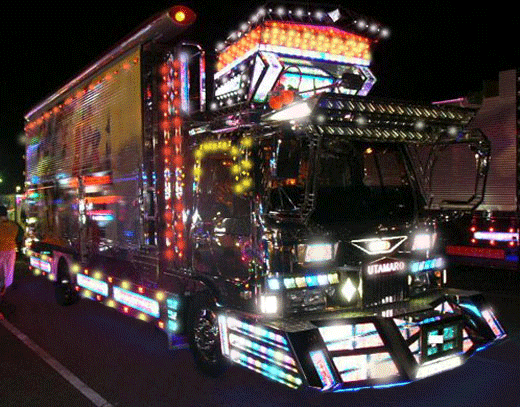Decotora In Wajima 2022 Ac (1) on:
[Wikipedia]
[Google]
[Amazon]

 , an abbreviation for "decoration truck", are a style of decorated
, an abbreviation for "decoration truck", are a style of decorated
Camion
From Geibunsha official website.

 , an abbreviation for "decoration truck", are a style of decorated
, an abbreviation for "decoration truck", are a style of decorated truck
A truck or lorry is a motor vehicle designed to transport cargo, carry specialized payloads, or perform other utilitarian work. Trucks vary greatly in size, power, and configuration, but the vast majority feature body-on-frame constructi ...
s in Japan. Commonly featuring neon, LED or ultraviolet light
Ultraviolet (UV) is a form of electromagnetic radiation with wavelength from 10 nanometer, nm (with a corresponding frequency around 30 Hertz, PHz) to 400 nm (750 Hertz, THz), shorter than that of visible light, but longer than ...
s, detailed paintjobs and murals, and stainless steel or golden parts (both on the exterior and the interior), dekotora may be created by workers out of their work trucks for fun, or they may be designed by hobbyists for special events. They are sometimes also referred to as .
History
In 1975, Toei released the first in a series of 10 movies called ''Torakku Yarō
is a series of ten Japanese action comedy films produced by Toei and released from 1975 to 1979. All ten films in the series were directed by Norifumi Suzuki and starred Bunta Sugawara as Momojiro Hoshi ("Ichibanboshi" or "first star") and Kinya ...
'' (''Truck Guys''). These films featured truckers who drove garishly decorated trucks around Japan. This movie was a hit with both old and young, and the ''dekotora'' fad swept the country. While ''dekotora'' were present throughout the 1970s, they were restricted to north-eastern fishing transport trucks prior to the movies. In those days, ready-made parts for trucks were not easily available, so these trucks took parts from sightseeing buses or American military vehicles.
Modern times
Since the late 1990s, ''dekotora'' have been heavily influenced by the art ofGundam
is a Japanese military fiction media franchise. Created by Yoshiyuki Tomino and Sunrise (now Bandai Namco Filmworks), the franchise features giant robots, or mecha, with the name "Gundam". The franchise began on April 7, 1979, with ''Mobile ...
. Other decorations are more akin to modern art and retro designs that closely resemble those found in the movie.
Styles
* Kansai-style * Kantō-style * Retro-styleSee also
*Dekochari
The is a form of art bike indigenous to Japan dating back to the mid-1970s. "Deko" in Japanese is short for "decoration" and "chari" is slang for "bike". The ''dekochari'' was a response by children to the Dekotora ("tora" is short for "truck") c ...
, bicycles modelled after ''dekotora''
*Itasha
In Japan, an is a car decorated with images of characters from anime, manga, or video games (especially ''bishōjo'' games or ''eroge''). The decorations usually involve paint schemes and stickers. The cars are seen prominently in places su ...
, cars decorated with anime
is hand-drawn and computer-generated animation originating from Japan. Outside of Japan and in English, ''anime'' refers specifically to animation produced in Japan. However, in Japan and in Japanese, (a term derived from a shortening of ...
characters
*Jeepneys
Jeepneys (), sometimes called jeeps (), are minibus-like public utility vehicles, serving as the most popular means of public transportation in the Philippines. They are known for their crowded seating and kitsch decorations, which have become ...
, trucks originally made from surplus American jeeps from WWII, and later being replaced by installing surplus parts from Japan aftermarket.
* Chiva buses, colourful buses primarily seen in Colombia and Ecuador
* Tap taps, painted Haitian "buses"
* Truck art in South Asia
External links
Camion
From Geibunsha official website.
References
{{portal, art, asia Trucking subculture Art vehicles Japanese subcultures Vehicles of Japan Public art in Japan